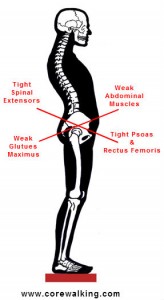 I never heard the term lower crossed syndrome until I started researching upper crossed syndrome which is a very popular term to throw around these days. The concept of the crossed syndromes is the brainchild of Vladimir Janda who I referenced last week.
I never heard the term lower crossed syndrome until I started researching upper crossed syndrome which is a very popular term to throw around these days. The concept of the crossed syndromes is the brainchild of Vladimir Janda who I referenced last week.
Even though I hadn’t heard of the lower crossed syndrome before it is basically the main piece of the body puzzle that I am helping people solve. Being self-taught leaves me in the dark about many theories but my instincts tend to lead me in the right direction.
We tend to be too long in the front and too short in the back. This happens because we lean backwards habitually. We lean backwards habitually for a number of reasons. The most obvious reason is that we can. We have an arch in our lower spine that we don’t know what to do with. As the first species with a curved spine I think we are confused about how to use it.
Another reason we lean backwards and develop lower crossed syndrome is because of the skeletal alignment of the legs and pelvis leading to an environment that forces us to lean backwards. If the bones aren’t aligned correctly—which means stacked one on top of the other—they will have to compensate for the misalignment.
If one bone moves forward, another often has to move backwards to balance the forward movement. This happens with individual bones as well. If the top of a bone moves in one direction its opposite end with likely move the other way.
The way it works in the body often follows a similar pattern. The knees lock backwards forcing the thighs forward. The thighs that are forced forward take the pelvis with it, either tucking it under or pulling it forward in a neutral position. The upper back rounds backwards against the forward movement of the pelvis and finally, the head moves forward to compensate for the backward movement of the upper spine.
Lower crossed syndrome encompasses all of the muscles I have written about in the last week (Here, here, here and here). What I see in my yoga students and client’s day in and day out is exactly the patterns described in the photo. Weak and tight are sometimes interchangeable but one way or the other these muscle groups all suffer as a group and need to be addressed together to make any successful and lasting changes.
***
